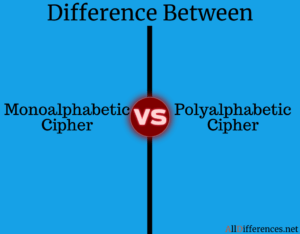Difference Between Monoalphabetic Cipher and Polyalphabetic Cipher
Contents
Comparison Between Monoalphabetic and Polyalphabetic Cipher(Tabular Form)

Comparison Chart
| Monoalphabetic Cipher | Polyalphabetic cipher |
|---|---|
| Once a key is chosen, each alphabetic character of plaintext is mapped onto a unique alphabetic character of a ciphertext. | Each alphabetic character of plaintext can be mapped onto “m” alphabetic characters of a ciphertext. |
| The relationship between a character in the plaintext and the characters in the ciphertext is one-to-one. | The relationship between a character in the plaintext and the characters in the ciphertext is one-to-many. |
| A stream cipher is a monoalphabetic cipher if the value of ki does not depend on the position of the plaintext character in the plaintext stream | A stream cipher is a polyalphabetic cipher if the value of id does depend on the position of the plaintext character in the plaintext stream. |
| Monoalphabetic cipher includes additive, multiplicative, affine, and monoalphabetic substitution cipher. | Polyalphabetic cipher includes autokey, Playfair, Vigenere, Hill, one-time pad, rotor, and Enigma cipher. |
Polyalphabetic cipher
- A polyalphabetic cipher is any cipher based on substitution, using multiple substitution alphabets. The Vigenère cipher is the best-known example of a polyalphabetic cipher.
- The Enigma machine is more complex but is still fundamentally a polyalphabetic substitution cipher.
Monoalphabetic Cipher
- A Monoalphabetic cipher is any cipher in which the letters of the plaintext are mapped to ciphertext letters based on a single alphabet key.
- Substitution ciphers work by replacing each letter of the plaintext with another letter. For this reason, a monoalphabetic cipher is also called a simple substitution cipher.
